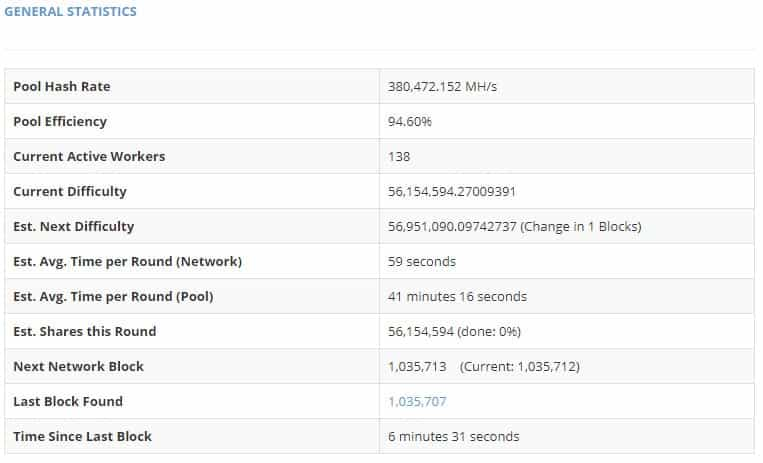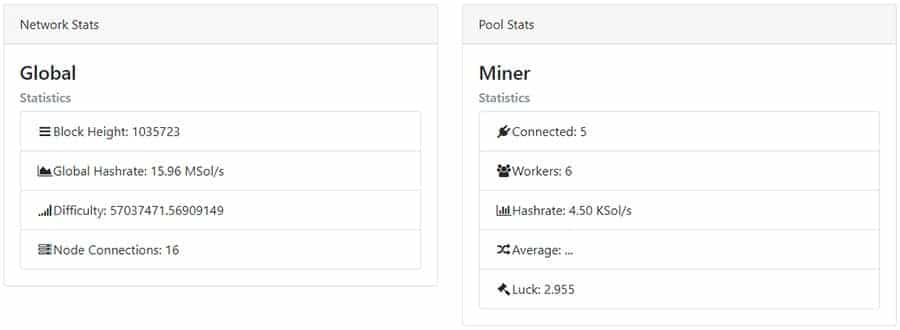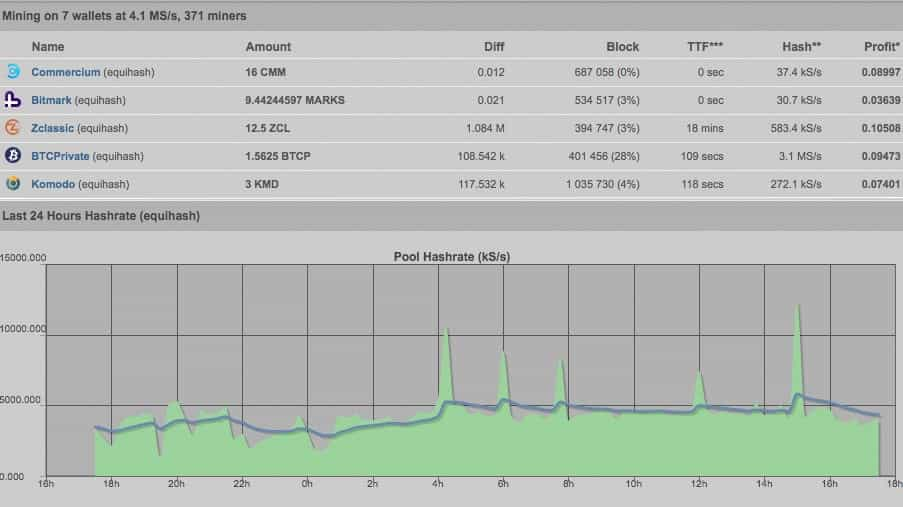The following article will give you some ideas for the best Komodo mining pools to use. If you aren’t familiar with Komodo, here’s a brief description of the project:
Komodo is a privacy-centric decentralized, open-source cryptocurrency that was evolved from Bitcoin Dark, but is a fork of ZCash. The lead developer is James “jl777” Lee, the same developer who created Bitcoin Dark.
He created Komodo using a fork of Zcash to include z-snark technology, and Komodo runs on the SuperNET platform, taking advantage of the software applications and infrastructure of that platform.
Komodo uses a Delayed Proof of Work (dPoW) protocol to keep its anonymous, private and transparent transactions ultra-secure. To learn more about Komodo you can read our Komodo Platform Review.
Pool Mining vs. Solo Mining Komodo
Until January 2018 you could still have a chance as a solo miner if you had a powerful GPU rig, but since then going it alone as a solo miner has become increasingly difficult due to the introduction of ASIC miners for the Equihash algorithm (which Komodo uses). These days you need a great deal of hashing power, or a great deal of luck, if you think you’ll find a block when solo mining.
Instead it’s become far better to just joining a Komodo mining pool and combine your resources with other Komodo miners. Sure you don’t get the full block reward, you have to split it with your mining pool companions, but at least you get some rewards, and you get them with a pretty even and regular distribution as well.

I want to also mention that if you don’t have an ASIC rig to mine with, even if you’re pool mining, you won’t be profitable, unless somehow you’re getting free electricity, and even then you won’t make much more than $0.25 a day. But if you just want to accumulate some Komodo, and you think the price will increase, then you can still go right ahead and use your GPU to mine.
Otherwise, get yourself an Antminer A9 rig, but beware that a new Antminer A9 costs nearly $3,000 from Bitmain, and even the A9 Mini unit goes for $745.
Komodo Mining Pool Considerations
Mining pool features are very similar from coin to coin, and Komodo is no different. Below is a quick run-down on what features you’ll want to look for in a Komodo mining pool to get your best experience and
Fees: Mining fees can range from 0% all the way up to 2%. Obviously a smaller fee is going to make you more profitable, with all else being equal.
Server Location: The pool you choose should have servers in your region of the world. If you’re in North America look for North American servers. The same goes for those located in Europe or Asia. Basically the closer the server is the more hashing power and profitability you’ll see.
Trustworthy: Make sure the pool you’re choosing has a history of making payments and of being trustworthy and reliable in general. The pools that have been around for a few years generally don’t have trust issues.
Payout Scheme: There are various payout schemes, with some more geared towards luck, and others based strictly on even sharing of rewards. Which you choose is a personal preference because over the long term it all evens out.
Pool Uptime: 100% is best. If the pool servers aren’t up you aren’t mining.
Minimum Payout: Minimums are typically set low enough to ensure the average miner will get a daily payout. It’s worth finding out what the minimum is though, because you really don’t want to wait a month to receive your payout.
Pool Hash Power: It’s always tempting to choose the mining pool with the greatest hashing power, since you know they’ll also be finding the most blocks. Try to temper that with some common sense however. Anytime you choose a pool that has more than 25% of the total hashing power you’re also promoting the centralization of mining for that coin. It’s better for the network if you choose a pool with a smaller amount of hashing power to keep things as decentralized as possible.
Best Komodo Mining Pools
There aren’t a huge number of Komodo pools, but there are enough to give you some choice. Below are the 5 best pools that we can recommend currently. There are probably another 10-15 you could consider, but when I was looking any of those had no miners or so few miners that they were mining with less than 10 Ksol/s hashrate.
Komodo Mining Pool
Komodo Mining Pool is the oldest and one of the largest mining pools out there for Komodo. It consistently has more than 40% of the hashing power, making it one of the pools you should actually avoid if you want to maintain a decentralized and secure network.

There’s a 1% pool fee, which is average, and a minimum payout amount of 0.5 KMD. They have miners located globally, and to maintain your privacy there’s no registration required, just use a valid Komodo address and you’re good to go.
Suprnova.cc
If you’ve done any pool mining at all you’ve almost certainly heard of Suprnova.cc as they are frequently one of the top mining pools for dozens of coins. One nice thing about that is that there’s a unified login that can be used across nearly all of those pools, so you don’t have to reset logins and worker information.

Suprnova.cc has the standard 1% mining fee and a nice low 0.1 KMD minimum payout. They hold about 15-20% of the total hashing power, making them a good choice if you want a solid pool that isn’t endangering the decentralization of the network.
Luckpool
Luckpool.org is a Canadian based pool, so is best used by those located in North America. It is a bit different from other pools in that it charges a smaller 0.5% miners fee, but also offers something they call the Miner’s Jackpot. This is a bonus paid to the miner who actually finds the block. In the case of Komodo the Miner’s Jackpot is 0.24KMD. This leaves 2.76 KMD + transaction fee rewards - pool fee for all miners.

They are also different in using the Pay Per Loyal Time Share (PPLTS) payout system. The minimum payout is just 0.1KMD and this is an anonymous pool, meaning there’s no need to register or provide any personal information. All you need is a Komodo address. They also control just 10% of the total hashing power, making them a solid mining pool, but small enough to maintain decentralization.
Coinblockers
Coinblockers has been around for several years, but they remain one of the smaller Komodo pools, with roughly 1% of the total hashing power of the network. That doesn’t stop them from being a good choice for a Komodo pool. The mining fee is 1% at Coinblockers and minimum payments are an ultra-low 0.01KMD.

It’s an anonymous pool with no registration requirements, which is perfect for a privacy-centric coin like Komodo. They also have support for NiceHash if you feel you’d like to rent hashing power and use it to mine Komodo.
Zpool
Zpool.ca is a large pool that mines dozens of algorithms and over 100 different coins. While you can request payment in KMD, and the minimum is just 0.05KMD, it could still take time to get paid as the pool may have to wait until a Komodo block is found before payments can be made. They currently only guarantee BTC payments, and you can mine Komodo, but get paid in Bitcoin if you like.

Note that with Zpool you choose the algorithm (Equihash in the case of Komodo) and Zpool decides which coin in the algorithm is most profitable to mine. This means you might not be mining Komodo at all times. It also means the hashing power of Zpool varies dramatically as a percent of the total. I’ve seen it below 10% of the total and above 70% of the total. Keep that in mind regarding centralization when you’re deciding which Komodo pool to use.
Conclusion
As you can see there are not only several good Komodo mining pools to choose from, but they each have their own unique features that differentiate them from each other. The only downside is that mining with a GPU is no longer profitable, and you really need an ASIC rig to be profitable when mining Komodo.
However, if you believe the price of Komodo will increase the lack of profitability now shouldn’t be a concern as you’ll become profitable as the price of KMD rises.
Disclaimer: These are the writer’s opinions and should not be considered investment advice. Readers should do their own research.



